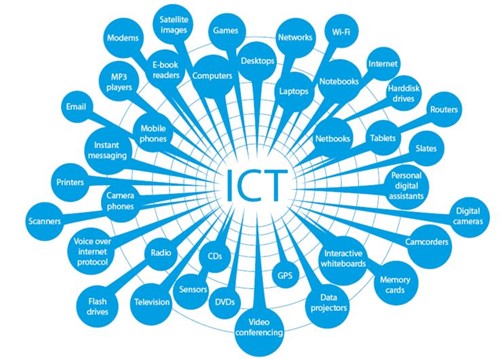When we start to think about the way that students learn today with ICT or technology, it often helps to reflect on how first we as adults learnt about new technology. I can remember when I started using ATMs. As an adult, I had a better understanding of the concepts involved. It was picked up quite easily. My usual trial and error methodology. Even today, I am sure with you too, it is the same way with any new technology such as the latest iPods or smart phone bought. Moving on, the point that I am trying to get across is that we do learn differently than to children. As teachers in the 21st century, we need to remember that.
Students in our classroom will learn how to use ICT in a variety of ways. These include through constructivism, social constructivism, situativity, ‘brain-based ideas, and then what I consider the most important, metacognition. I know….sounds very theoretical and it is as most of our understanding of how children learn is influenced by theorists and researchers of the nineteenth and twentieth century. However, my aim here is to make this as easy and understandable for you as possible. So in turn I will deliver it to you from a teacher’s perspective.
Constructivism
A key part of developing student ICT capability is the continual practice of students reflecting on their ICT learning. Reflection is a constructive process and it helps to create mental structures. It is important that the students in your class learn to reflect on the use of ICT – the techniques used, concepts learnt and the processes that they went through. Conceptual understanding is also significant and in this approach you can help students to challenge any naïve ideas through teacher intervention. In addition, you can help resolve any cognitive conflict through conceptual change. What I like about this is that this can be quite valuable in Learning Areas such as science, mathematics and any other subject where you may need to demonstrate simulations of situations that are difficult to practically achieve, but possible through the implementation of ICT.
Social Constructivism
The ICT industry plays a significant role in the national economy today and well into the future. Collaboration is something that it is well known for and throughout my teaching experiences I have encouraged and prompted many students to do the same in their projects. While the previous approach worked on the individual mind this one focuses on the many. Thus the reason why this idea has become the basis of many approaches to using ICT in the classroom. It is important to note, however, collaboration works best in a technology-rich learning environment.
Situativity
It is essential for a student today in secondary school to experience real-life experiences and for quite some time now, even before I finished school back in the 90s, this trend has been growing in importance. Apparently, this is what is known as the ‘situativity’ theory. So it refers to taking students outside the typical educational settings and giving them a taste of how different applications that they learnt in the classroom can be used outside of school. Some examples would be possibly doing work experience which the original one, but today in most Learning Areas in secondary curriculum you can apply this to. ICT is no exception to this as today the use of ICT is throughout businesses, organisations and corporations. Providing students with real-life experiences in this industry can certainly inspire, engage and encourage students in their learning. Furthermore, ICT experiences can bring a real sense of authenticity to their classroom activities.
'Brain-based' Ideas
Everyone has a preferred learning style and as teachers, we should recognise that in our students. This is to do with what the theorists' term as ‘brain-based’ ideas and is based on the claim that, although we all use visual, auditory, and kinaesthetic activity in learning we do choose to use one more than the others. ICT devices such as multimedia presentations do help speed up the learning process as it is more effective due to images, animation, and sound that it uses. As a result, it is better than any oral/verbal exposition. Kinaesthetic is offered to students too through their interactivity with the mouse and keyboard.
Metacognitive Knowledge
The last one is such that of much importance when it comes to developing ICT capability in the classroom. Higher order thinking skills are vital for students and are mainly concerned with what is known as ‘metacognitive’ knowledge. An ICT capable student is not someone who simply knows all about the various devices that exist and the techniques. What makes a student capable is their ability to know what they know and are able to decide if that skill or technique is appropriate for the solution to the problem. With the many ICT devices and applications that we expose students to this makes it very important as it will affect how students will approach a task and how successful they are likely to be. Being successful will give them a sense of self-efficacy and this will enable them to choose to do a task and to be comfortable in taking risks. In addition to this, students must be able to think that their success is due to their effort as opposed to factors outside of their control.
All of the above represent different ways that students can learn using ICT. It is crucial that when choosing to develop ICT capability within the classroom that you take into account the students’ existing experiences and abilities. Understand too that students especially in primary education will learn differently to us as adults. Past research has indicated that you don’t have to demonstrate everything to them as a teacher and that their more capable peers will help. It has also stated that the number of times an individual child will need to see an ICT technique demonstrated and practice to become knowledgeable of it will depend on the age and experience of the child. So when deciding to develop student ICT capability it is best to make sure that it is just right!

Understanding ICT Sklills
What is ICT?
ICT stands for Information and Communication Technology and is to do with the everyday usage of digital technologies such as computers, smartphones, tablet computers, sending emails and text messages, Internet, making video calls etc.

Taken from UNESCO
What are ICT skills?
Determining what do you learn in ICT skills comes down to understanding what exactly they are. ICT skills or to use another term, ICT techniques is a key component of ICT capability. They can become a key routine in the process of developing ICT capability as routines also is a component. It is for this reason, why I believe that developing ICT capability is better than learning ICT skills. Although there are varying degrees of ICT skills and some are more advanced than others, ICT techniques require a degree of conscious thought.
ICT techniques are also likely to involve an interface factor and are specific to the software tool being used. Software designers often ensure that ICT techniques can be transferred to different programs.
What is the best way to learn ICT skills?
If you want to know just how to learn ICT skills/techniques it is recommended that you do not learn it in a single context as this will make it difficult for you and your students to generalise. If ICT techniques are met in a variety of contexts and situations, the potential for reflection and concept development will grow.
Students need to associate involved in an ICT technique with the effect it achieves. Having a name for the ICT skill/technique is helpful. The name should be seen as not as something extra to learn but as a means of communicating and thinking about the action and its effect.
Focus on the concept behind the ICT skills/techniques to help develop conceptual understanding and to further promote the ability to ‘.know that you know’. This is called metacognitive and it is what makes you be able to understand where the ICT techniques that you know work best to achieve the desired goal.